Overview
Documentation on application features for specialists.
Specialist Features
These features are available to specialists in addition to the General features.

Finding available work
From the specialist dashboard, the features supports finding content that needs to be worked according to one of two tabs:
- Concepts - in scope unmapped work
- QA - failed QA checks that have not yet been reviewed
The list of available work can be searched/filtered or paged through. Assigning work is done by clicking at the "Claim" icon to the left of each entry. Batches of up to 100 concepts can also be claimed by using the "Claim Batch" button.
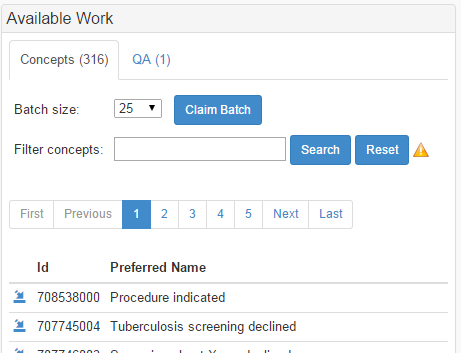

Assigning work
Assigned work fits into the same two categories as available work for a specialist. Once assigned work can be edited by clicking on the icon to the left of each entry. Clicking on the icon to the right will return work back to the pool for assignment. Concepts can also be searched/filtered and paged from this view. There are four radio buttons for seeing assigned work in different stages of the SPECIALISTs workflow
- All - all assigned work of this type
- New - assigned work that has not yet been started.
- Editing - assigned work that is still being edited
- Finished - assigned work that is done but has not yet been submitted for the next workflow review.
For New, Editing, and Finished work, the state of work performed to date is indicated by the type of icon to the left of each entry:
- New: A pencil icon
- Editing: A pushpin icon
- Finished: An underlined checkmark icon
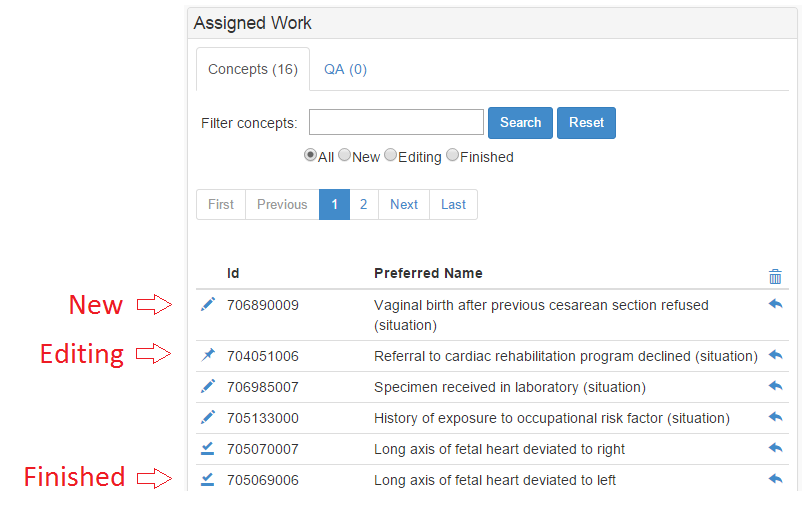

Editing assigned work
To edit assigned work, click the icon to the left of the record. The tool will display the map record editing dashboard. A labeled screenshot is shown below, with descriptions of each component below the screenshot.
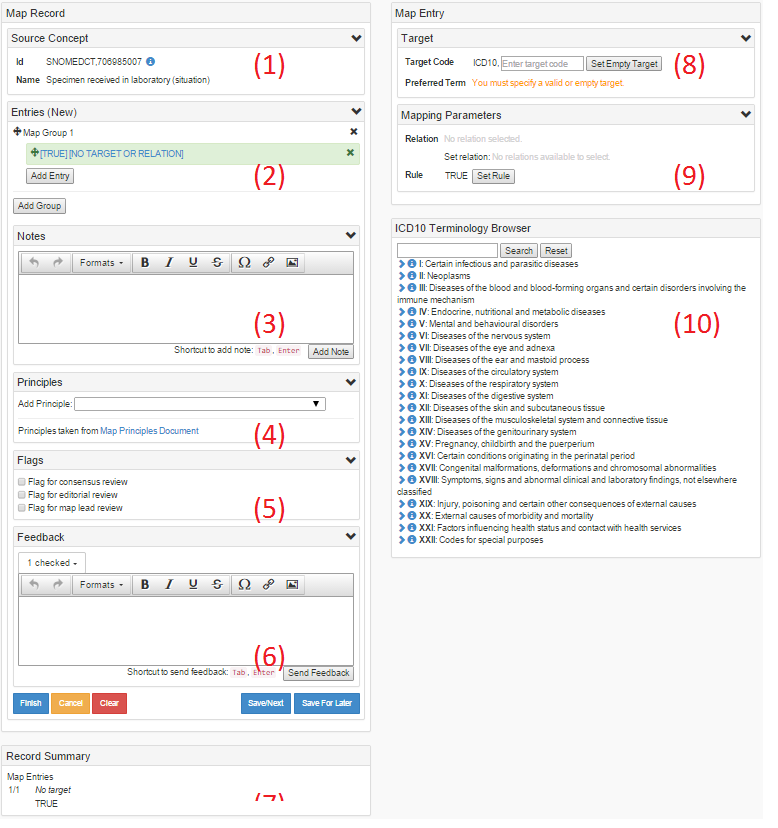
- Source Concept Details Panel
- Displays the source terminology, concept id, and concept name.
- If the source terminology is SNOMEDCT, a blue information icon is displayed. Clicking this opens the SNOMEDCT Concept Browser
- Map Group and Map Entries Panel
- Displays a summary current map entries attached to the record, sorted by group. The entry currently being edited is highlighted in green.
- To add a map group or entry, click the Add Entry/Group buttons.
- Entries and groups can be deleted by clicking the "x" icon attached to the desired element. Note that deleting a group will also delete all of its entries.
- Entries and groups can be reordered by drag-and-drop.
An example of multiple groups and entries is shown below, with the current entry highlighted in green.
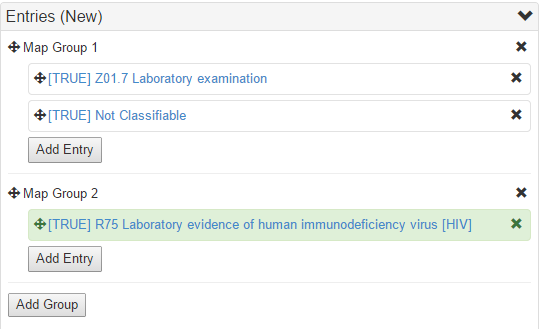
- Map Notes Panel
- Displays any notes currently attached to the record. Notes can be deleted by clicking the "x" icon on the desired note.
- To add notes to the record, enter some text into the rich text editor and click "Add Note".
- Note can be entered directly or copied and pasted from external sources such as websites or MS Word documents, with formatting preserved. This editor supports the following elements:
- Basic formatting (bold, italics, underline)
- HTML elements (e.g. <p>, <div>, anchor tags, hyperlinks)
- HTML image elements hosted on another website/server
A sample note is shown below.

- Map Principles Panel
- Displays any principles currently attached to the record. Principles can be deleted by clicking the "x" icon on the desired note.
- Principles can be added from the drop-down box, with displayed principles taken from the hyperlinked document.
An example of an applied principle is shown below.

- Flags Panel
- To flag a record for review, simply click the checkbox.
- The three currently supported flags are Consensus Review, Editorial Review, and Lead Review.
- Feedback Panel
- Displays any communication between the user and anyone else involved in a discussion about this record.
- To submit new Feedback to one or more leads attached to the project, enter text and click "Send Feedback".
- Feedback can be formatted in the same ways Map Notes can (see #3)
- Record Summary Widget: Displays a summary of the current state of the record as edited.
- Target Panel:
- Displays the currently selected target code and Preferred Term for the selected map entry (highlighted in green in #2)
- To change the target, enter the target code into the text box and click "Set Target".
- If the entry has no target, this must be explicitly indicated by clicking "Set Empty Target" when the text box is empty
- Mapping Parameters Panel:
- Displays the map relation, map advices, and map rule for the selected map entry (highlighted in green in #2)
- Only those parameters appropriate to the current project are displayed. For example, if the project is not rule-based, the "Rule" row and button will not appear.
- If map relations are available for this project and selected target, a drop-down menu will appear with those relations valid for assignment.
An example of an assigned relation with drop-down options is shown below.

- To set the rule (for a rule-based project), click the "Set Rule" button. A modal pop-up will prompt for the Rule Category and any required parameters. Click "Add Rule" to finish setting the rule.
An example of using the Rule Constructor to set a chronological age requirement is shown below.
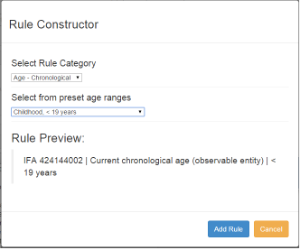
- If Map Advices are available for this project and selected target, a drop-down picklist will appear with those advices valid for assignment. Advice can be added by simply selecting the desired item in the drop-down box. Advice can be removed by clicking the "x" icon on the displayed advice values.
An example of advices attached to the entry is shown below.

- Terminology Browser Panel
- Displays a nested-tree structure representing the target terminology.
- The terminology browser has three major components, which are marked in the screenshot below.
- Search Tools
- To perform a search, enter text and hit Enter or "Search". The tree will change to reflect only those nodes (and parents) that match the search terms.
- To reset the search, hit "Reset". The tree will revert to the full top-level hierarchy for the terminology.
- Searches are remembered for each session; to go forward or back use the arrow buttons.
- Tree Node Controls
- If a target code has children, toggle display of those children with the arrowhead button preceding the target code.
- If a target code does not have children, it is a leaf node and a leaf icon will appear.
- If a target code has additional information (e.g. inclusions, exclusions), toggle display of that information with the blue information icon.
- If a target code is valid for assignment, assign this entry to the current entry (see #2, #8).
- Information Panel: Displays any relevant information for this target code. Depending on the target terminology, may contain clickable links to other target codes or code ranges. Clicking these links will perform a new search based on the linked content.
- An example of a search for "cholera" performed in the Terminology Browser for ICD10 is shown below.


Finishing assigned work from the dashboard
When viewing assigned work with the Editing filter applied, a new option appears to finish work for either (1) individual concepts or (2) all currently assigned concepts presently in editing.
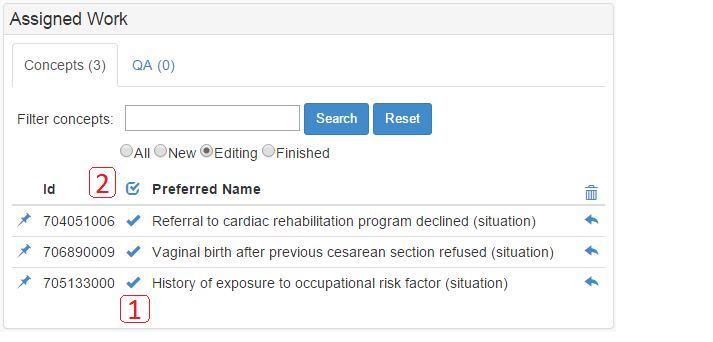
Clicking either button will display a modal pop-up window displaying a summary of the record and results of record validation:
- If the record cannot be validated successfully, the reasons for validation failure will be displayed and an orange "Skip" button will be shown. See the first example below.
- If the record is successfully validated, a blue "Finish" button will be shown. See the second example below.
- Clicking "Finish All" will attempt to validate all records currently in editing, but will only successfully finish work on those records that fail validation.
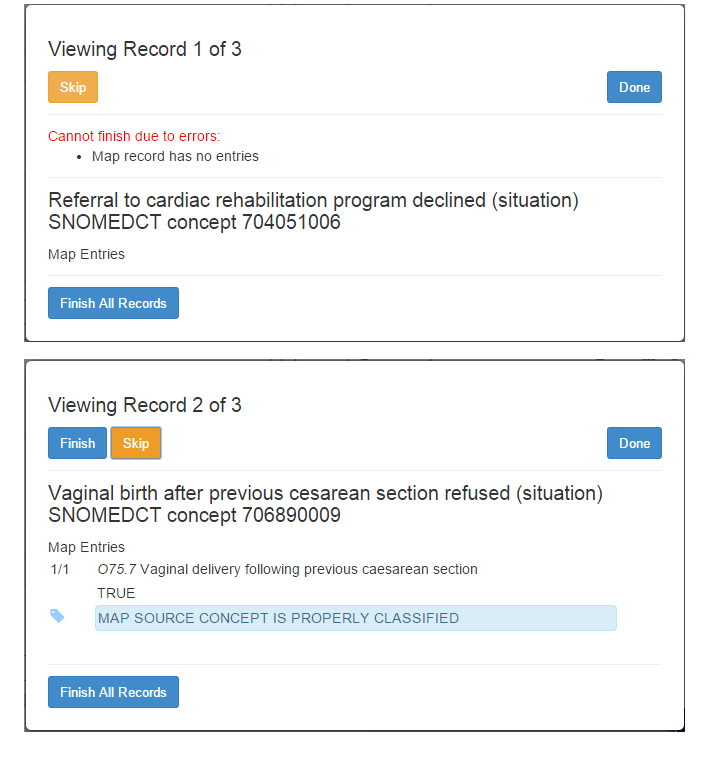

Recently edited work
TODO

Feedback
TODO

Feedback Conversations
TODO

Index Viewer
TODO
References/Links

![]()









